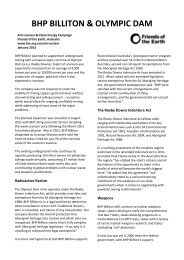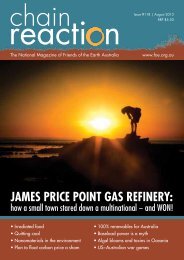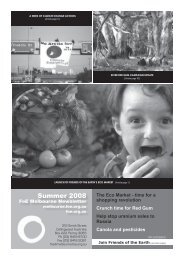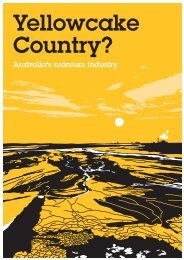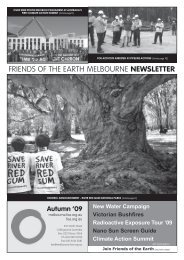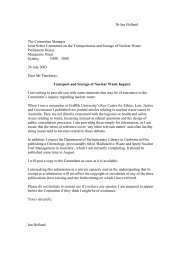Thirty Years of Creative Resistance - Friends of the Earth Australia
Thirty Years of Creative Resistance - Friends of the Earth Australia
Thirty Years of Creative Resistance - Friends of the Earth Australia
Create successful ePaper yourself
Turn your PDF publications into a flip-book with our unique Google optimized e-Paper software.
The FoEA magazine Chain<br />
Reaction (or CR) began as <strong>the</strong><br />
‘Greenpeace Pacific Bulletin’<br />
in 1974 as a combined effort<br />
<strong>of</strong> <strong>the</strong> developing FoE groups<br />
and Greenpeace who were<br />
collectively opposing nuclear<br />
tests in <strong>the</strong> Pacific.<br />
It changed its name to Chain Reaction<br />
in 1975 and began its life as a foolscap,<br />
fordigraphed newsletter. Peter Hayes,<br />
Barbara Hutton and Neil Barrett were<br />
among <strong>the</strong> founding editors.<br />
In later years, Neil recalled that ‘in <strong>the</strong><br />
heady days <strong>of</strong> May 1975, not one <strong>of</strong> <strong>the</strong><br />
intense, hairy activists present would have<br />
imagined that it would still be going 25<br />
years later … The main energy came from<br />
Peter Hayes, one <strong>of</strong> those rare beings who<br />
could still think clearly enough to write a<br />
succinct report on an outrageous demo<br />
in some mining company <strong>of</strong>fice after two<br />
days without sleep’.<br />
In its early editions, CR <strong>of</strong>ten had an<br />
emphasis on practical issues such as how<br />
...................................................................................................................................................................................................<br />
to build a wind generator, along with more<br />
<strong>the</strong>oretical and philosophical discussions<br />
and reports on campaigns.<br />
After a few editions, it was decided to<br />
expand CR’s anti-nuclear focus in order<br />
to become a national ‘activist-orientated’<br />
environmental journal.<br />
It described itself in 1977 as ‘publishing<br />
feature articles and news on national and<br />
international issues and searching for<br />
<strong>the</strong> way towards a sustainable, convivial<br />
society which lives in harmony with its<br />
environment.’<br />
That same edition reflected its activist<br />
base and orientation by publishing an<br />
apology for its lateness: ‘absenteeism<br />
reached 100% during <strong>the</strong> Swanston<br />
Dock actions’ where mounted police led<br />
a charge over <strong>the</strong> top <strong>of</strong> protesters sitting<br />
on a wharf beside a ship loaded with<br />
<strong>Australia</strong>n uranium.<br />
Commenting on <strong>the</strong> police’s heavyhanded<br />
tactics at <strong>the</strong> protest, Chief<br />
Police Commissioner Miller said ‘I’d use<br />
elephants if I had <strong>the</strong>m’. These and o<strong>the</strong>r<br />
protests led to a partial victory when <strong>the</strong><br />
shipping <strong>of</strong> uranium through Melbourne<br />
was halted.<br />
CR continued to define its political position,<br />
which varied and evolved considerably<br />
as time went by and as different people<br />
worked on <strong>the</strong> magazine.<br />
In 1978, <strong>the</strong> editors defended <strong>the</strong>mselves<br />
from accusations that CR was a socialist<br />
rag: ‘We do not follow any political party<br />
line. We consider people’s welfare<br />
to be more important than economic<br />
development for its own sake – if that<br />
is socialism, <strong>the</strong>n what is wrong with<br />
socialism’<br />
While some in CR and FoE have<br />
advocated for various forms <strong>of</strong> ecosocialism,<br />
<strong>the</strong> political culture <strong>of</strong> FoE has<br />
always ensured a deep scepticism <strong>of</strong><br />
actual political parties and parliamentary<br />
processes.<br />
The early 1980s seemed to be a time<br />
where <strong>the</strong> editors <strong>of</strong> <strong>the</strong> day had a very<br />
clear sense <strong>of</strong> <strong>the</strong> magazine, and both its<br />
and FoE’s role in creating long term social<br />
FoE 30 <strong>Years</strong> 120



